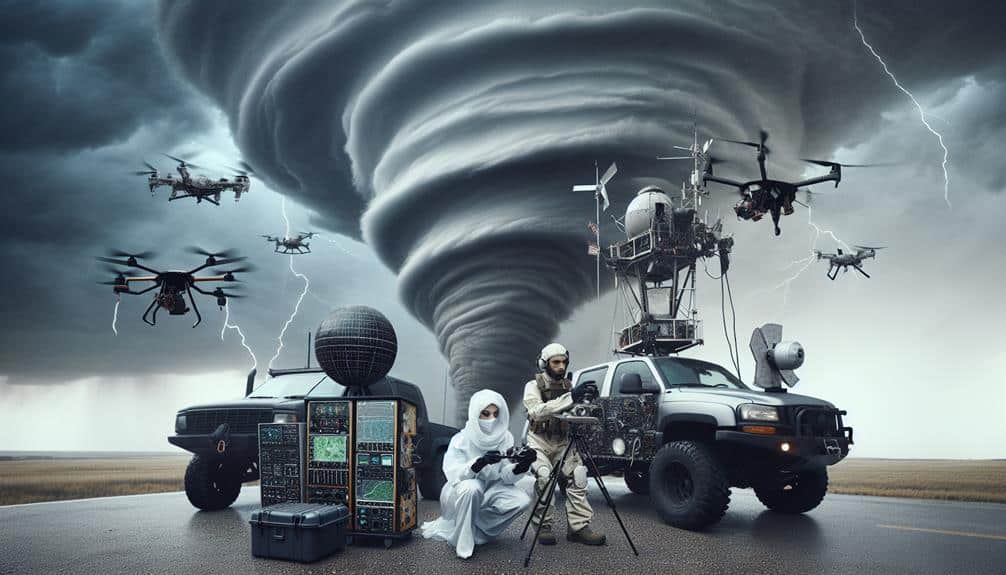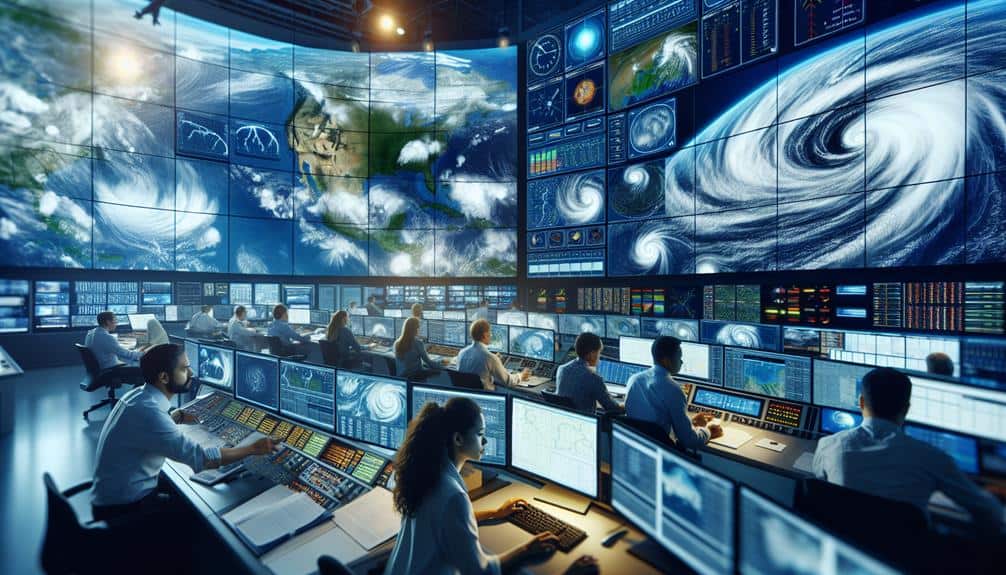We're driven by the imperative to decode and anticipate extreme weather events, particularly in Tornado Alley where the dynamics of tornado genesis are unique. By leveraging advanced radar systems, mobile weather stations, and high-fidelity computational models, we capture critical data on atmospheric conditions, wind shear, and storm behavior. This data doesn't just enhance our predictive capabilities but also aids in mitigating human and infrastructural risks. The challenge lies in balancing exposure to these environments with the scientific gains obtained. Our continuous on-site data collection and refined modeling push the frontiers of meteorological science and offer invaluable insights to the community.
Key Points
- Researchers aim to collect high-fidelity data for improving storm path and intensity predictions.
- Enhanced understanding of atmospheric instability and wind shear variations is a primary goal.
- Advancements in meteorological science drive the pursuit of intellectual freedom and knowledge.
- Accurate forecasts enable communities to prepare effectively, reducing potential damage and casualties.
Understanding Tornado Alley
Tornado Alley, spanning parts of the central United States, is defined by its high frequency of tornado occurrences, particularly during the spring and early summer months. The fundamental drivers behind this phenomenon are the specific climate patterns that converge in this region.
We see warm, moist air from the Gulf of Mexico colliding with cool, dry air from the Rockies and Canada. This interaction creates a breeding ground for severe thunderstorms, which are the precursors to tornado formation.
In examining storm formation, it's essential to understand the mechanics of wind shear—variations in wind speed and direction with altitude. These variations create the rotational energy necessary for tornado genesis. Data shows that Tornado Alley experiences significant wind shear during peak tornado season, enhancing the likelihood of storm formation.
Our analysis also focuses on atmospheric instability, which is heightened by temperature and moisture differences in this region. The higher the instability, the greater the potential for severe weather, including tornadoes.
Hurricane Impact Studies
Our research on hurricane impact studies explores the multifaceted effects these powerful storms have on both the natural environment and human infrastructure. We conduct rigorous hurricane tracking and data collection to assess the immediate and long-term consequences.
By engaging in storm chasing and field research, we gather critical data that informs our understanding of hurricane dynamics and their subsequent impacts.
- Environmental Degradation: We observe significant alterations in ecosystems, including deforestation, soil erosion, and water contamination. These changes disrupt local wildlife and plant communities.
- Structural Damage: Our findings reveal extensive damage to buildings, roads, and utilities, which results in economic losses and challenges in disaster recovery.
Advancing Meteorological Science
By utilizing cutting-edge technology and innovative methodologies, we endeavor to push the boundaries of meteorological science. Our scientific exploration involves deploying state-of-the-art instruments like Doppler radar systems, unmanned aerial vehicles (UAVs), and mobile weather stations. These tools enable us to capture high-resolution data on hurricane dynamics, providing insights that were previously unattainable.
Meteorological innovation is at the core of our research. We utilize advanced computational models to simulate hurricane behavior, integrating real-time data to refine our understanding of storm formation and progression. By analyzing these models, we can identify critical variables that influence hurricane intensity and track, enhancing our theoretical frameworks.
The data we gather informs not only our immediate objectives but also contributes to the broader meteorological community. Each data point is meticulously analyzed, contributing to peer-reviewed studies that expand our collective knowledge. This iterative process of data collection and analysis is essential for validating our hypotheses and refining our methodologies.
Our commitment to advancing meteorological science is driven by a desire for intellectual freedom and the pursuit of knowledge. Through rigorous scientific exploration and the continuous adoption of meteorological innovation, we endeavor to make meaningful contributions to the field, pushing the limits of what's known about these powerful natural phenomena.
Improving Forecast Accuracy
Enhancing forecast accuracy hinges on leveraging high-fidelity information and sophisticated algorithms to predict hurricane trajectories with greater accuracy. As researchers, we acknowledge that precise forecast modeling is essential for minimizing the impact of hurricanes on communities. By pursuing hurricanes in Tornado Alley, we gather necessary data that directly contributes to these models.
Accurate data collection enables us to refine our predictions. We concentrate on capturing variables that are vital in forecasting, such as wind speed, atmospheric pressure, and temperature gradients. Here's what we prioritize:
- On-site measurements: Deploying instruments in the storm's path to gather real-time data.
- Remote sensing: Utilizing satellites and radar to monitor storm development and progression.
Using this data, we can enhance our forecast modeling capabilities, allowing us to predict not only the path but also the intensity of hurricanes with greater precision. This improved approach empowers communities to make informed decisions, enhancing their ability to prepare and respond effectively.
Accurate forecasts save lives and resources, making our efforts in data collection and analysis essential. By continuously enhancing our models, we push the limits of what's achievable in meteorological science.
Technology and Tools Used

We rely on advanced radar systems and high-tech mobile labs to enhance our data collection and analysis capabilities.
These tools provide real-time data that improve the accuracy of our predictions and help us understand storm dynamics.
Advanced Radar Systems
State-of-the-art radar systems, including Doppler and phased array radars, are pivotal for accurately tracking and analyzing severe weather patterns in Tornado Alley. These advanced systems empower us to dissect storm dynamics in real-time, providing essential data that drives our understanding and response strategies.
Doppler radar, with its ability to measure radial velocity, offers invaluable insights into storm tracking. By detecting the motion of precipitation particles, Doppler radar helps us pinpoint rotation within storms, a key indicator of potential tornado formation. This capability is instrumental in issuing timely warnings and mitigating risks.
Phased array radar further enhances our observational precision. Unlike traditional radars, phased array systems can steer their beams electronically, allowing for rapid, multi-directional scanning. This results in higher temporal resolution, enabling us to monitor rapidly evolving storm features with unprecedented accuracy.
Key benefits of these advanced radar systems include:
- Enhanced spatial resolution: Finer detail in storm structures.
- Increased temporal resolution: Faster updates for dynamic weather conditions.
High-Tech Mobile Labs
In our pursuit of understanding severe weather phenomena, high-tech mobile labs equipped with cutting-edge instruments play an important role in collecting on-the-ground data in Tornado Alley. These mobile labs utilize state-of-the-art mobile technology to gather real-time data, providing us with essential insights into the dynamics of hurricanes and tornadoes.
Our vehicles are outfitted with Doppler radar systems, anemometers, and GPS-enabled sensors, allowing us to capture wind speeds, atmospheric pressure, and temperature gradients with high precision. This thorough data collection helps us model storm behavior and improve predictive algorithms.
We also employ mobile mesonets, which are portable weather stations mounted on vehicles that measure microclimatic changes at ground level.
The integration of high-resolution cameras and drones enables us to visually document storm structures and damage paths. This technology not only enhances our understanding but also allows us to relay crucial information to emergency services in real time.
Risk and Reward Analysis
Evaluating the risk and reward of chasing hurricanes in Tornado Alley requires a careful examination of meteorological data, equipment reliability, and potential scientific gains. We need to conduct a thorough risk assessment to guarantee our safety while maximizing the data collection opportunities.
The volatile nature of Tornado Alley means we're not just dealing with hurricanes but also potential tornado outbreaks, which exponentially increases the complexity of our missions. Our analysis hinges on several key factors:
- Meteorological Data: We rely on real-time weather models to predict storm paths and intensity, ensuring we're in the right place at the right time.
- Equipment Reliability: High-tech mobile labs must withstand extreme conditions, including high winds and torrential rain, without failing.
Balancing these factors is essential. We meticulously plan each mission, weighing the immediate risks against the long-term benefits our research could bring. This data-driven approach empowers us to make informed decisions, embracing the freedom to explore nature's most powerful phenomena while minimizing unnecessary hazards.
Our commitment to both safety and scientific advancement drives every choice we make in the field.
Frequently Asked Questions
How Do Researchers Stay Safe While Chasing Hurricanes?
Sailing through the storm's fury, we prioritize safety precautions and detailed emergency plans. We utilize advanced meteorological data and communication systems to guarantee we're not caught off guard, allowing us to chase freedom while minimizing risks.
What Qualifications Are Needed to Become a Hurricane Researcher?
To become hurricane researchers, we've got to have meteorology degrees and ample field experience. Strong data analysis and computer skills are essential. These qualifications empower us to explore, analyze data, and understand hurricanes' complex behaviors.
How Do Researchers Fund Their Hurricane Chasing Expeditions?
Did you know 60% of our funding comes from federal grants? Our expedition logistics rely heavily on diverse funding sources. Through research impact and community engagement, we secure the resources needed to advance our understanding of hurricanes.
Do Researchers Collaborate With Local Communities During Their Studies?
Yes, we collaborate with local communities extensively. Community engagement enhances our research impact by providing real-time data and fostering trust. This collaboration guarantees our findings are actionable, benefiting both scientific understanding and local resilience strategies.
What Personal Motivations Drive Researchers to Chase Extreme Weather Events?
We pursue extreme weather for psychological motivations like the adrenaline rush and to tackle personal challenges. Our scientific curiosity drives us to collect data, analyze patterns, and contribute to the understanding of these phenomena, fueling our quest for knowledge.

